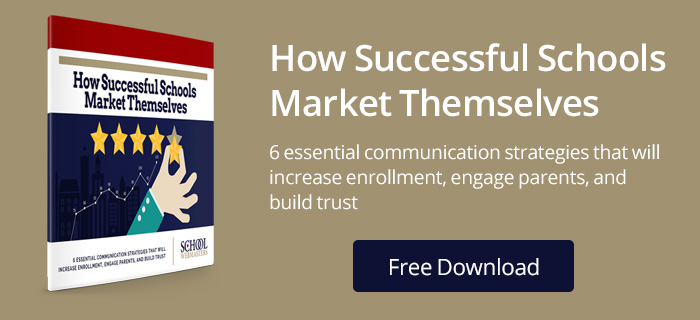Wouldn’t it be strange to attend a school sporting event only to see the principal as the only player representing the school? Picture the scene: he or she didn’t have time to change before the event, so he’s/she’s still wearing business attire and carrying a laptop from the afternoon faculty meeting. Who would likely be in the bleachers cheering on that team of one? At first, many might come to see the surprising sight, but soon, loyalty to the “team of 1” would very likely wane as the team stats took a nosedive since opponents would be, by far, more capable of working towards victory as a team.
Successful schools communicate to their parents and students that they are part of a team, not just observers whose presence matters very little. In general, the more your school community is in the “game,” the more your bleachers fill with spectators. And this audience should not to be underestimated; in football, spectators are known as the 12th man and can give a team an edge. Students are a school’s secret weapon to rallying your school community. If you inspire a student with a school program, activity, initiative, etc., your efforts will be multiplied by their enthusiasm to the get the word out to their family and friends. Increased parent engagement through your students is a crucial part of successful school public relations and marketing.
Download our FREE eBook: How Successful Schools Market Themselves.
Shared Interest
As a school administrator, you care about the success of your students for a variety of reasons. In turn, parents care about individual students and their success for a variety of reasons. Any math teacher will agree the greatest common factor here is the students and their success. And it is no secret that parent involvement is a benefit to schools. So, how do schools foster successful parent partnerships?
In 2016, the Library of Congress Literacy Awards program gave their top honor, the David M. Rubenstein Prize, to the Reading Rockets project. On their website is an article published by The Center for Comprehensive School Reform and Improvement. The article states:
Schools successful in engaging parents start by going beyond narrow definitions of involvement. They don’t just count the number of parents who attend the spaghetti dinner or volunteer at the book fair. They don’t focus on requirements such as having parents sign reports cards. Instead, they start with a belief that student success is a shared interest of both school and family, envision parents as partners in the learning process, and then identify concrete ways that partnership can be activated.
So, how should schools engage parents? By getting their students in the game. Here are four ways to reach out to your students, build positive relationships with them, and enlist their help to market your school.
Don’t Put Students On the Bench
When students are not key players in your school, you can bet that your parent support will be minimal. Consider ways to place your students in starting roles at your school. How often do you recognize students at your school? Is it only your star athlete or top academic student? What about the rest? Do their efforts, successes, and ideas matter and deserve school praise? As a parent, I will walk, swim, bike, or drive to recognize my child’s triumphs.
Now, this doesn’t mean that everyone needs to have a ribbon or trophy simply for being there, but I believe our schools have the potential to recognize student successes much more often than they do these days. Recognition doesn’t even have to be grandiose either. It can be as simple as positive communication from the principal or other school faculty recognizing the good in a student. I love this video from Glenbard District 87 where teachers shared positive words with their students. Clearly those students are the star players!
Effectively getting your students on board with school marketing is no small task. So how can your students help market for your school? Three core principles are at the heart of properly marketing to your students so that they, in turn, market for your school.

1. Talk the Talk and Walk the Walk
One of my memories of high school is running into my principal during the few times I was out in the hallways during class. I don’t know how often he was in the halls, but he always seemed to be when I was there. Mr. Waite, a high-ranking officer in the National Guard, never seemed to miss a chance to reach out to his students—even in passing.
As a school administrator, regularly evaluate your overall communication approach. Consider your interactions with others and the overall tone of these interactions during a typical day in your busy schedule. There are many ways we communicate with others throughout the day. Are you interacting with students negatively or positively? Directly or indirectly? How often? Communication goes beyond daily interactions with students and others. Our relationship with others throughout the day work on a form of banking; if you constantly withdraw from your interactions with students or others in a critical way but very rarely deposit praise, that interaction will not inspire a student to speak well of you or anything else related to your school.
2. Establish a School Brand That Your Students Care About
I hesitate here because I worry that administrators might read that and think, “Why does it matter if our students care?” Students are in school because education is important. And educators do their best to provide high-quality education. Lost in the midst of that, sometimes, is whether or not the students are invested in the school. Student investment and engagement go hand-in-hand in establishing positive public relations for your school, and, in the long run, marketing your school.
As a high schooler, I hated my high school. I thought it was cliquish and the administration’s highest priority was the football team. I had no school pride. Now, as an adult, I wouldn’t send my children there, and I wouldn’t recommend the school to others. That’s not the kind of relationship your school wants with your students and alumni. By establishing a school brand that cares about your students, and, in turn, your students care about you lay the foundation for good school PR and positive school marketing.
A Lesson from Fast Food

One valuable principle I learned as a PTO president was this: if you manage to effectively enthuse students about an activity, parent engagement follows. Parents attend events, volunteer to participate and provide support when their children encourage them. We call this “McDonald’s marketing.”
Why do kids ask to eat at McDonald’s? Because the brand appeals to them—from the meal that comes in their own personal little box complete with a toy to the indoor playgrounds. Consider this: What do parents get out of the McDonald’s experience? Sure some may just love the menu options, but most of us take joy in watching our kids happily play in the playroom or enjoy their delight over that cheap little toy. The fact is, the result of a happy child outweighs whether or not the parent prefers other restaurants. Your school brand needs to appeal to your students if you want it to appeal to their parents as well.
3. Be Original
As you work to establish a brand your students care about, remember to be original. It’s no secret that millennials value originality, and it behooves your school to put effort into providing a fresh take on education.
There are many ways and platforms on which to be original these days without breaking the school’s budget. A school that values originality sets itself apart from other schools. Consider the various platforms you have available: school social media, your school website, newsletters, spirit weeks, etc.
Consider your school’s priorities in what you want to offer your school community. How can you put an original spin on it? No ideas? Involve your students and get a fresh perspective. Apart from student councils, do you include students in your other meetings at school? Students today want to be engaged, and engagement fosters loyalty. Consider involving students in brainstorming meetings or having student focus groups contribute their thoughts on important topics. As you allow your students to contribute, you help them catch your vision as well as take an ownership in that vision and band. As you engage students, they will naturally become advocates and help your vision succeed
It Makes a Difference
Your efforts in these three areas will make a difference. Here are just a few school categories that are impacted by effective school marketing:
- Student enrollment
- Funding increases (taxes, tuition, fundraising)
- Quality teacher recruitment
- Parent engagement and support
- Student performance
- Staff morale
- Student spirit
- Building trust and confidence
If a student and his/her family feel a sense of rewarded satisfaction for their time and effort, you are on your way to establishing earned trust from your community. As your school repeats this over and over in your school community, that trust grows, strengthening your school brand.
Basically, if my child believes in it—I’m for it. If the school succeeds in giving my child the vision, it’s going to be difficult to keep my family from participating. Make your students your star players by getting them involved and invested in your school. Parent engagement will naturally follow.

Emily Boyle, School Content Specialist


